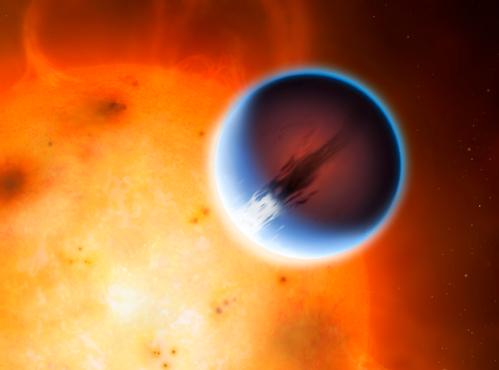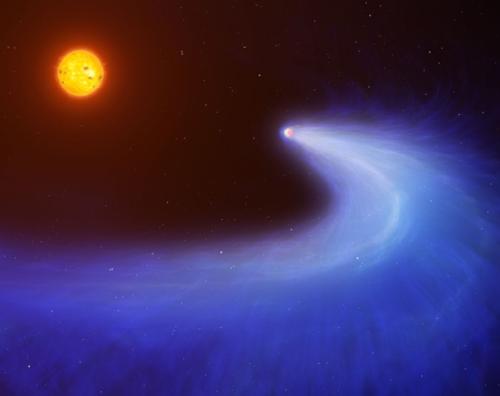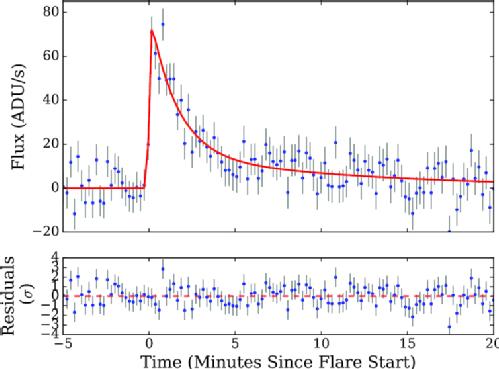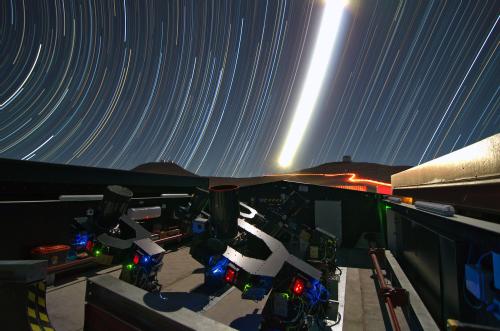Exoplanet Atmospheres PhD Project
Supervisor: Peter Wheatley
For this project you will use data from wide range of telescopes to explore the atmospheres of newly discovered transiting exoplanets. This can include the composition of the atmosphere, the formation of weather systems including winds and clouds, the irradiation of atmospheres by X-rays and ultraviolet light from the parent star, and the effect this has on planetary evaporation and habitability. You will also have the opportunity to contribute to the discovery of new exoplanets in wide orbits around their parent stars.
Please contact me directly to find out more and discuss how the project might be tailored to your particular interests.
Atmospheric composition and weather systems
We will probe the composition of planetary atmospheres using the technique of transmission spectroscopy, where opacity sources in the planetary atmosphere are revealed in high-precision spectra taken during a transit of the planet across the face of its parent star. This can reveal the presence of specific atoms and molecules in the planetary atmosphere, as well as clouds and photochemical hazes. With transmission spectroscopy at high spectral resolution we can also detect Doppler shifts due to winds in the planetary atmosphere, and begin to map global climate systems.
|
|
Artist's impression of our discovery of a high-speed eastward wind around the equator of the hot Jupiter HD189733b. With my former PhD student, Tom Louden, we used the high-resolution HARPS spectrograph in Chile to resolve the Doppler shifts of each side of the planet. This discovery confirmed predictions from global climate models that the intense heating of the planet would drive an eastward jet in the atmosphere. You can read the full journal article here and the Warwick press release here. (c) Mark Garlick and University of Warwick. |
X-ray irradiation and atmospheric evaporation
We can measure the X-ray emission of exoplanet host stars using ESA's XMM-Newton space telescope and NASA's Chandra mission. This will allow us to calculate the X-ray irradiation of the planetary atmosphere, and use atmospheric escape models to estimate the rate of mass loss from the planet. We will model this mass loss on timescales of billions of year in order to understand how X-ray irradiation sculpts the observed population of exoplanets. This evaporation may explain the lack of Neptune-sized planets found orbiting close to their parent stars, as well as the bimodal distribution of planet radii found with NASA's Kepler mission.
|
|
Artist's impression of our discovery of comet-like tail of hydrogen gas escaping the atmosphere of the Neptune-sized planet GJ436b. The atmospheric escape is driven by irradiation of the atmosphere by X-rays from the corona of the host star. Neptune-sized planets are particularly sensitive to atmospheric escape, and close-in hot Neptunes may be evaporated to destruction leaving behind a small rocky core. You can read the full journal article here and the Warwick press release here. (c) Mark Garlick and University of Warwick. |
Stellar flares and the habitability of Earth-sized exoplanets
We can use ground-based telescopes to search for giant flares from low-mass stars that will irradiate potentially habitable exoplanets with intense ultraviolet light. This ultraviolet radiation may be intense enough to cause mass extinctions of life forms on Earth-sized planets. On the other hand, it is also possible that the ultraviolet light from stellar flares is needed for life to begin around low-mass stars, where a relative absence of ultraviolet light is thought to limit the progress of pre-biotic chemistry in the atmospheres of exoplanets.
|
|
Our discovery of a giant stellar flare on a tiny ultracool star. With my former PhD student, James Jackman, we used the telescopes of the Next Generation Transit Survey in Chile to search for the characteristic brightening of a low-mass stars when magnetic energy is released suddenly in their coronae. In this case the star brightened by 10,000 times! Earth-like planets in its habitable zone would have been bathed in intense ultraviolet light that might cause mass extinctions. You can read the full journal article here and the Warwick press release here. |
Discovery of new transiting exoplanets
We can also use the telescopes of the Next Generation Transit Survey in Chile to search for new transiting exoplanet around bright stars. By combining with data from NASA's TESS spacecraft we can find cool planets in wide orbits around their host stars. These new discoveries will allow us to study planetary atmospheres that are not intensely irradiated by their parent star, making them good analogues for habitable exoplanets. These new planets will also provide a connection between exoplanet atmospheres and the relatively well understood atmospheres of the planets in our own Solar System.
|
|
Photograph of some of the telescopes of the Next Generation Transit Survey in Chile, which we use to search for new transiting exoplanets. I lead this project and we control the telescopes from Warwick. With my postdoc, Sam Gill, we recently discovered a Saturn-sized exoplanet in a wide orbit around its parent star. Studying the atmospheres of these relatively cool exoplanets provides a connection to habitable exoplanets and the planets in our own Solar System. You can read the full journal article here and the Warwick press release here.
|




